30-06-2022
UNAM’s Imprint in Germany. Challenges and opportunities
The internationalization of UNAM has been present throughout the one hundred and twelve years of its history. Evidence of this was the creation of the Foreign Students Learning Center (CEPE, Spanish initials), which recently celebrated its first centenary. The concept of internationalization, however, has changed and today touches on many aspects in addition to the dissemination of culture. In the irreversible trend of a globalised, changing and massively communicated world, the role of universities is no longer relevant only on a national scale. The information generated in universities has a global reach and it is inevitable and inconceivable to think of higher education as being disjointed from international complexity.Thus, UNAM has set itself the goal of moving towards an institution that is at the service of the country and humanity, through the training of professionals, to carry out research mainly on national conditions and problems, and to extend, as far as possible, the values of Mexican culture in global contexts. The commitment to Mexican and global society goes beyond the classrooms and laboratories. Its primary purpose links the university with the world through the academic links generated between higher education institutions (HEIs) and between governments (Fernández and Velázquez, 2020).
In the national context, UNAM is the first university in Mexico, with its origins all the way back to 16th century, and was founded as a National University in 1910. It is a comprehensive institution of higher education, with twenty-nine schools and sixty research entities, where more than twenty-five percent of the total annual number of academic articles in Mexico are produced (UNAM, 2021 Tarango and Machin-Mastromatteo, 2016). Its educational offer is broad, with more than one hundred and thirty undergraduate degrees and eighty-four postgraduate degrees of excellence. In the international context, UNAM is the highest ranked university in the country and one of the top 100 in the world (according to QS World University Rankings, QS, 2022). The knowledge generated in its classrooms and laboratories is reflected in the academic output it publishes year after year. By 2020 UNAM registered its participation in 6308 scientific articles in International Science Indicators (Sun and Yuan, 2020).
In the interactive process of knowledge generation, different participants are involved, which is why collaboration between academics and national and international institutions is a constant. Academic cooperation is a practice that is historically carried out in different areas of knowledge, which is why cooperative ties are a fundamental key to UNAM’s internationalization strategy. However, academic cooperation is limited by its regional links and is strengthened or weakened according to policies and strategies that are defined around academic, socio-political, economic and cultural conditions.
As part of its strategy to provide its community with the best alternatives for internationalization, UNAM has thirteen offices in nine countries. One of the regions, Europe, is home to four of them, located in Spain, the United Kingdom, France and, most recently, Germany. The following is a succinct description of the history of scientific collaboration between UNAM and higher education institutions in Germany, one of the sixteen countries for which the site is responsible in its region of influence. It should be clarified that the information is limited to what is available in the Scopus database (Elsevier, 2022) and leaves out an extensive legacy of other collaborations that have not yet been included in that source. The search included joint publications between UNAM academics and peers at other HEIs between 2010 and 2020.
UNAM IN EUROPE
UNAM has shared co-authorship with twenty one European countries in 21 700 academic articles. In this first approximation, Spain, Germany, the United Kingdom and France stand out as the countries with which UNAM has published more than fifty percent of its total scientific production. It also confirms that these countries have one of the highest rates of mobility, both for students and academics. It is therefore justifiable that UNAM has sites that represent and contribute to collaboration in each of these countries (figure 1).
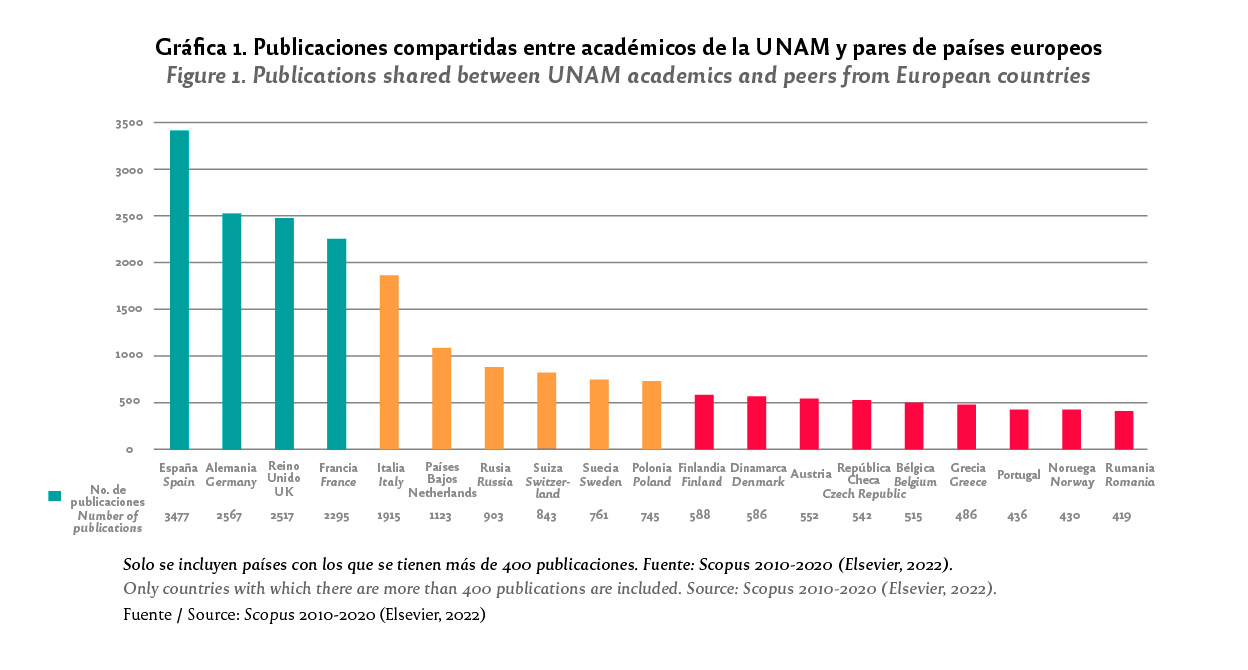
UNAM IN GERMANY
UNAM Germany began operations in 2018 at the International House of the Free University of Berlin. The aim of all the offices abroad is to promote and consolidate UNAM’s prestige in the world in terms of teaching, research, academic outreach, dissemination of culture and as a benchmark in the teaching of Spanish. The specific mission is to be the institutional link between UNAM’s schools and departments with key partners: HEIs, agencies and research centres, and to facilitate long-term academic cooperation.
Although it focuses on Germany, the headquarters supports UNAM in internationalization issues in sixteen neighbouring European countries. UNAM’s cooperation with these countries is extensive: as an indicator, 10 653 scientific articles have been published, i.e. forty-nine percent of the total scientific output shared between UNAM and Europe. Germany is undoubtedly the best represented country, followed by the Netherlands and Russia as highly empathetic partners in scientific collaboration with UNAM (figure 2).In our analysis we aimed at identifying the prevalence of collaboration between UNAM and Germany by subject area, while recognising that the humanities and social sciences are under-represented in the Scopus database. With that caveat, UNAM maintains consolidated cooperation with German HEIs in the physical and mathematical sciences and engineering, where seventy percent of the total is accumulated. Natural sciences are the second-best represented area, with twenty-five percent, and the rest is under-represented due to the nature of the database and the mechanisms of science communication (figure 3). Humanities and social sciences use modalities such as the publication of books and book chapters, reviews and manuals that are generally not considered in Scopus and other science networks. Regarding undergraduate student mobility, between 2017 and 2020, UNAM sent two hundred and sixty-seven students to HEIs in Germany and received one hundred and thirty- five. This mobility included forty-two German HEIs, twenty of which host the highest reciprocity in terms of mobility (figure 4). The University of Munich and the Free University of Berlin receive the most UNAM students, while the University of Munich and the Technical University of Berlin send the most exchange students to UNAM. The overall balance is an average of two UNAM students for one German exchange student. This shows an imbalance which is generally observed with HEIs in the other countries in the area of influence.
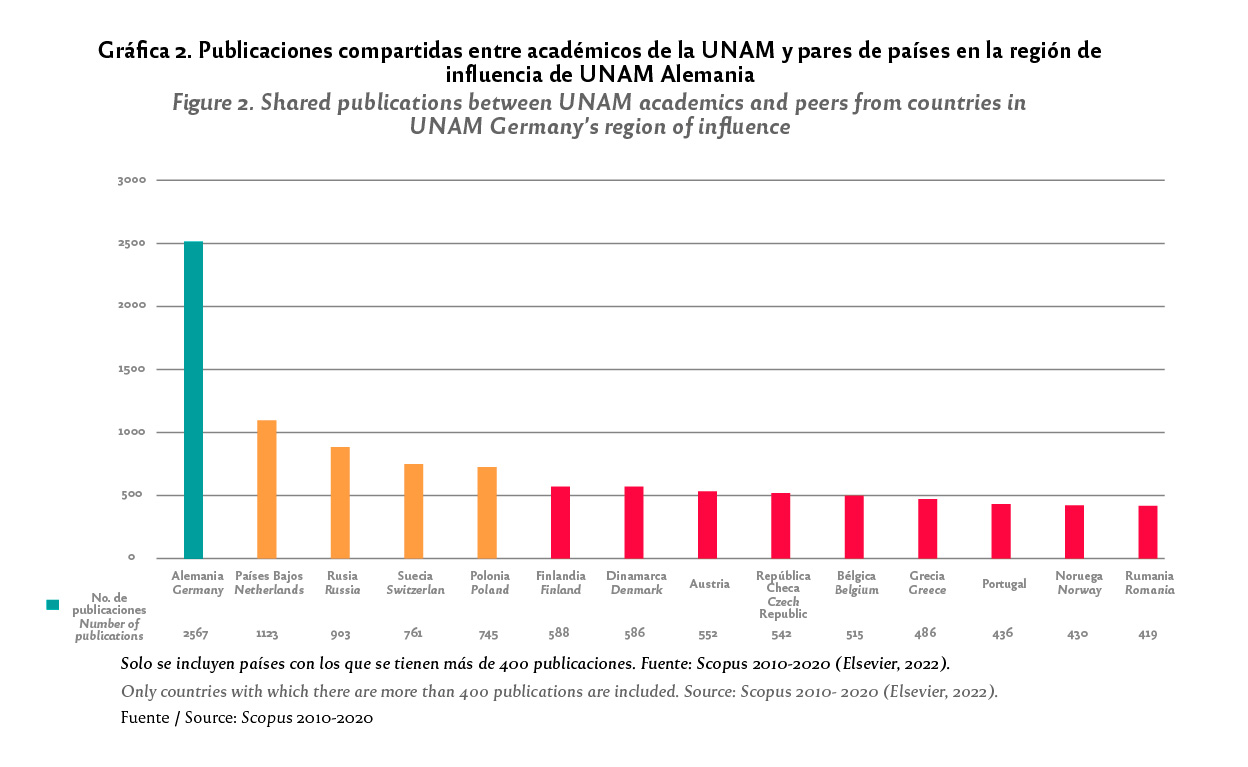
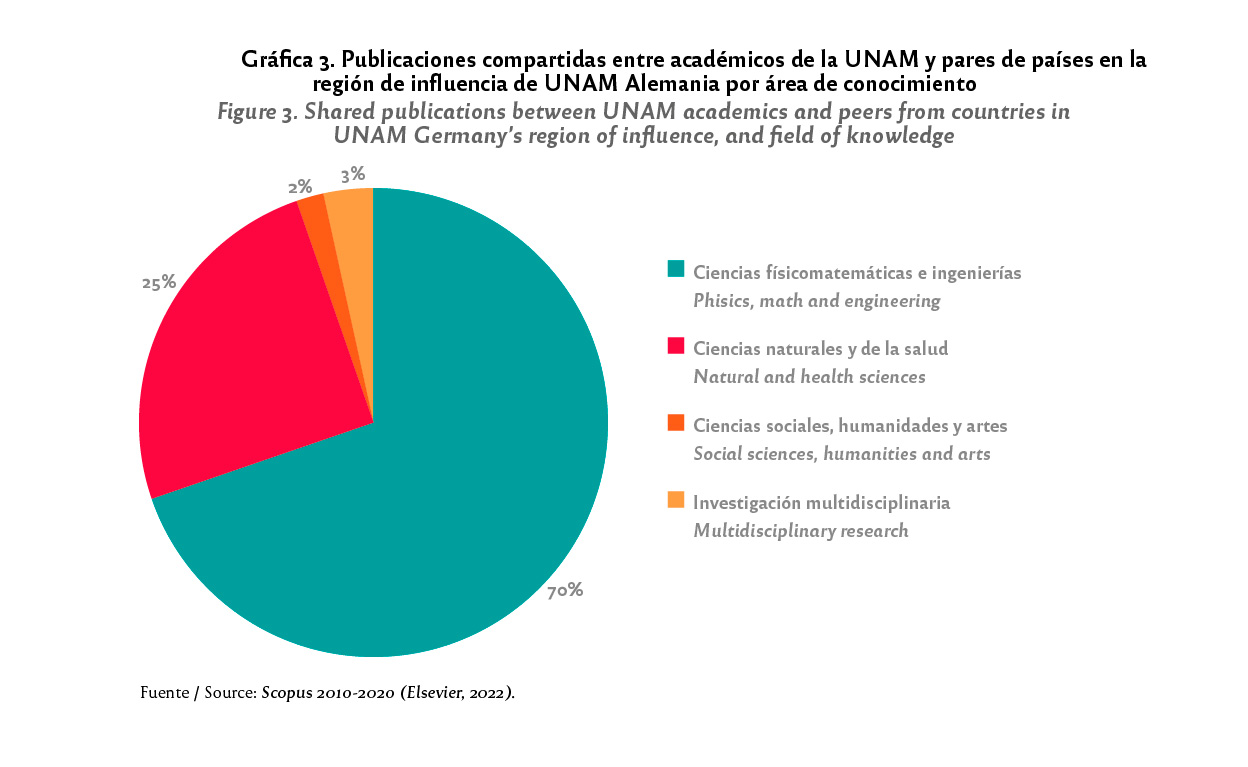
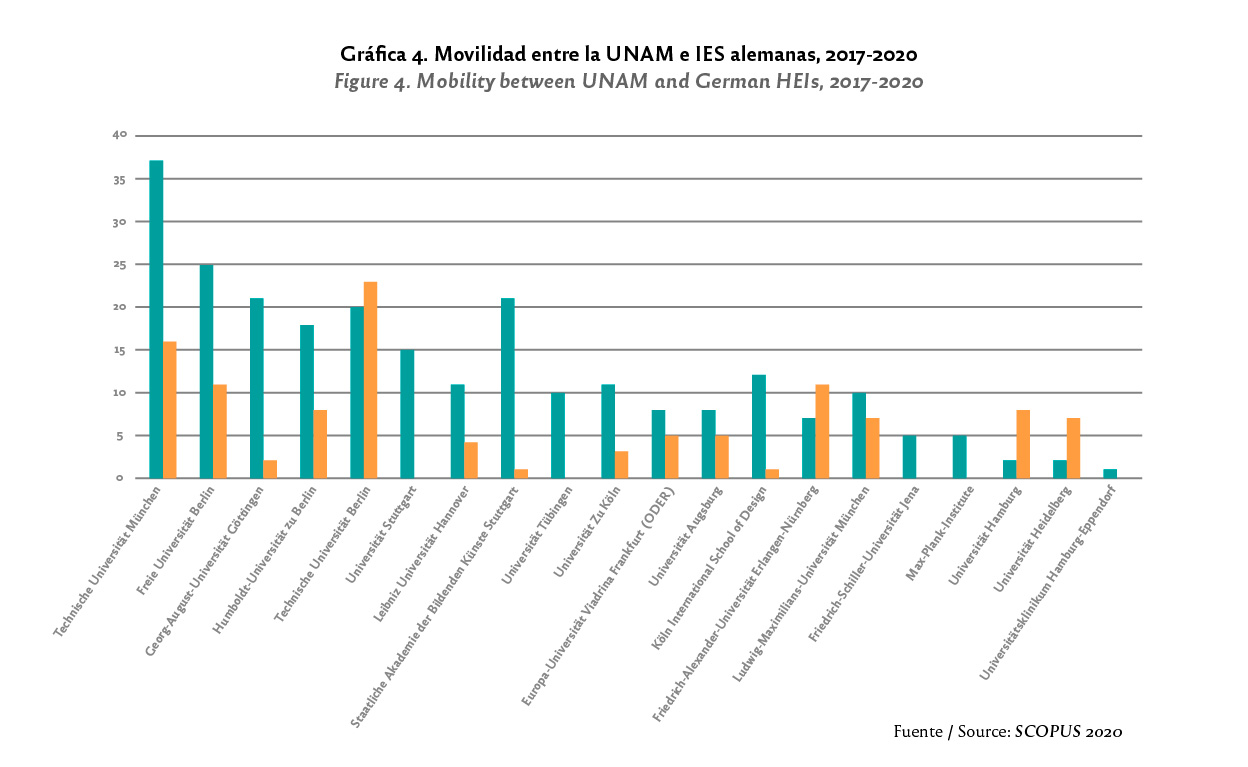
The combination of the three parameters —outgoing mobility, incoming mobility and joint publications— revealed a pattern of areas of opportunity to be addressed. Figure 5 shows a significant mismatch between the German HEIs with which UNAM publishes most compared to those with which UNAM has more incoming or outgoing mobility. The University of Heidelberg, which has the highest rate of scientific production with UNAM and a very low rate of undergraduate mobility, stands out. This contrasts with the Free University of Berlin, UNAM’s home in Germany, with which collaborative scientific production is very poor (at least that represented in Scopus); similarly with the University of Munich, with which the highest mobility is observed, but which has a significantly lower collaborative scientific production than the University of Heidelberg.
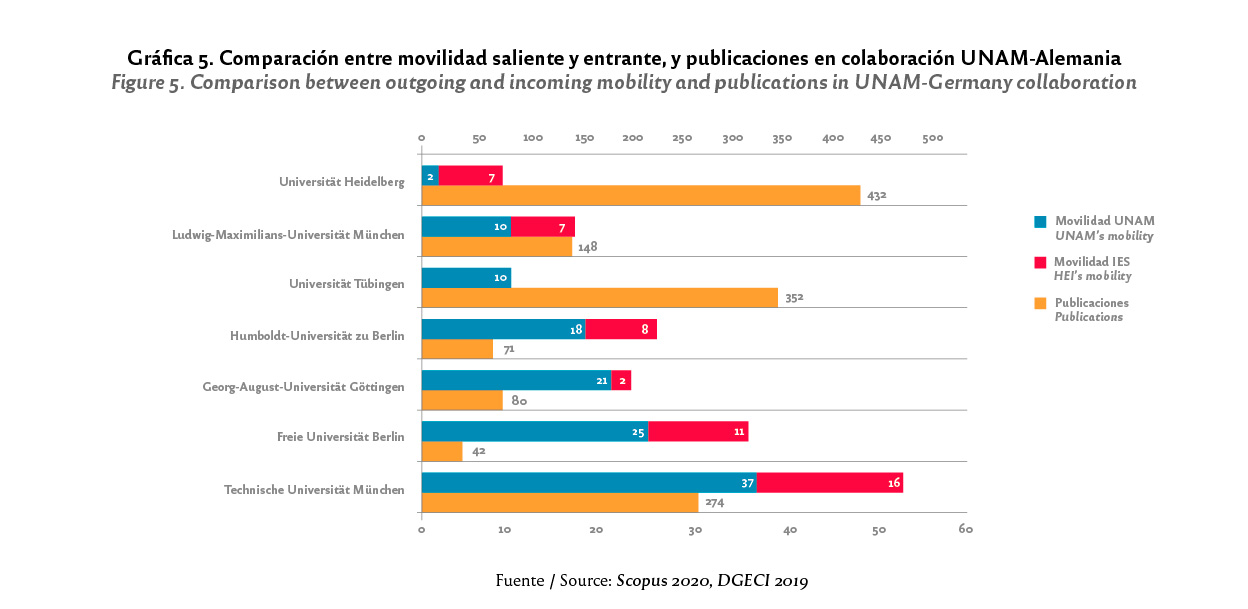
AREAS OF OPPORTUNITY
UNAM’s Berlin office was created in 2018 with the aim of promoting internationalization in Germany. The health contingency invited to rethink and expand the strategy and since 2020 a major effort has been made to collect data from institutional and international platforms that reflect the relationship between UNAM and German HEIs. The goal is to gain a deeper understanding of the context of the already existing links between the two communities and to develop targeted strategies to support and promote inter-institutional collaborations.
The analysis carried out over the last few years has made it possible to identify and prioritize the actors with whom UNAM should promote connections, as well as the role played by each of them. HEIs, academic cooperation agencies, companies and the governmental and social sectors are among the strategic partners and each of them plays a specific role in the international strategy.
For UNAM-Germany, we highlight the approach with the two most relevant academic cooperation agencies in the region: the German Research Foundation and the German Academic Exchange Service (respectively DFG and DAAD German initials). The close relationship that has been built with both agencies has made it possible to work on the development of platforms that support academic exchange at all levels and areas of knowledge from institutional point of view.
In the case of the DFG, the result of this effort showed in the signing of an agreement in early June 2022, and will ensure the financing of scientific cooperation between academics from German HEIs and UNAM for a period of five years. The DAAD will organise a week-long meeting of Mexican rectors in Germany, where they will visit the most important institutions in Germany to promote the DAAD’s calls for proposals, academic exchange, and the funding of research projects.
UNAM Germany has worked in parallel with training, exchange, and research support agencies in order to consolidate collaboration with German HEIs with which there is already a history of common benefit, as well as to motivate UNAM’s academic entities and German HEIs with which there is little collaboration to also establish cooperative ties.
We still have to elaborate on the insertion of companies and cooperation agencies, as well as the opportunities of the European Union (EU) in its regional context. UNAM has been recognised by the EU as a key partner and areas of cooperation are yet to be discovered. Development issues such as pandemic care and prevention, projection of pharmaceutical and automotive industries, Mexico’s railway project and the mitigation of the effects of climate change through clean energies are examples of common topics for Mexico and Germany. The social capital to address them is the task of HEIs in general. UNAM’s role as the core institution for academic work in Mexico implies a responsibility to strengthen itself, and for this purpuse, German HEIs represent a valuable opportunity.
Alejandra Fregoso is a biologist from UNAM and MSc from ITC-University of Twente, Netherlands. She is Intra- and Intersectoral Coordinator of UNAM-
Germany.
Alejandro Velázquez is biologist and MSc from UNAM and Ph.D. from the University of Amsterdam, Netherlands. He is Director of UNAM-Germany.
Andrea Guillén has a degree in Administration from UNAM and is currently Deputy Director of UNAM-Germany.
English version by Edmundo Borja.
References
Dirección General de Cooperación e Internacionalización (DGECI) de la UNAM. Datos de movilidad con Instituciones de Educación Superior Alemanas. 2019.
Elsevier (2022). Scopus (base de datos en línea). www.scopus.com
Federico Fernández y Alejandro Velázquez (2020). La internacionalización de la universidad pública, retos y tendencias: una visión desde la UNAM. Ciudad de México: UNAM. ISBN: 20074298, 20074476. https://www.unaminternacional.unam.mx/doc/dgeci/libro-la_internacionalizacion_de_la_universidad_publica.pdf
Sun, J., Yuan, B. Z. (2020). “Bibliometric mapping of top papers in Library and Information Science based on the Essential Science Indicators Database”. Malaysian Journal of Library and Information Science, 25(2), 61-76.
Tarango, J., Machin-Mastromatteo, J. D. (2016). “Scientific production in Mexican universities: Rates and expectations toward competitiveness”. Information Development, 32(1), 107-111.
Universidad Nacional Autónoma de México (2020). La UNAM en números. México: UNAM. http://www.estadistica.unam.mx/numeralia/
Quacquarelli Symonds QS (2022). QS World University Rankings (base de datos en linea). www.topuniversities.com
Germany.
Alejandro Velázquez is biologist and MSc from UNAM and Ph.D. from the University of Amsterdam, Netherlands. He is Director of UNAM-Germany.
Andrea Guillén has a degree in Administration from UNAM and is currently Deputy Director of UNAM-Germany.
English version by Edmundo Borja.
References
Dirección General de Cooperación e Internacionalización (DGECI) de la UNAM. Datos de movilidad con Instituciones de Educación Superior Alemanas. 2019.
Elsevier (2022). Scopus (base de datos en línea). www.scopus.com
Federico Fernández y Alejandro Velázquez (2020). La internacionalización de la universidad pública, retos y tendencias: una visión desde la UNAM. Ciudad de México: UNAM. ISBN: 20074298, 20074476. https://www.unaminternacional.unam.mx/doc/dgeci/libro-la_internacionalizacion_de_la_universidad_publica.pdf
Sun, J., Yuan, B. Z. (2020). “Bibliometric mapping of top papers in Library and Information Science based on the Essential Science Indicators Database”. Malaysian Journal of Library and Information Science, 25(2), 61-76.
Tarango, J., Machin-Mastromatteo, J. D. (2016). “Scientific production in Mexican universities: Rates and expectations toward competitiveness”. Information Development, 32(1), 107-111.
Universidad Nacional Autónoma de México (2020). La UNAM en números. México: UNAM. http://www.estadistica.unam.mx/numeralia/
Quacquarelli Symonds QS (2022). QS World University Rankings (base de datos en linea). www.topuniversities.com
